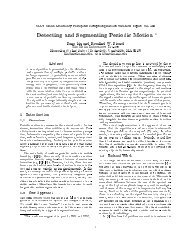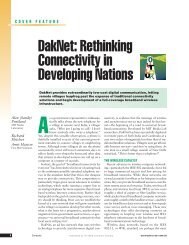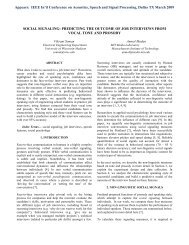'Honest Signals' in Business - Human Dynamics Group - MIT
'Honest Signals' in Business - Human Dynamics Group - MIT
'Honest Signals' in Business - Human Dynamics Group - MIT
You also want an ePaper? Increase the reach of your titles
YUMPU automatically turns print PDFs into web optimized ePapers that Google loves.
function and activity level is tight enough that we have been able to use it <strong>in</strong> cl<strong>in</strong>ical trials toaccurately estimate the severity of depression and even predict treatment response. 13And f<strong>in</strong>ally, consistency seems to be a measure of the <strong>in</strong>tegration with<strong>in</strong> our bra<strong>in</strong>'s actionsequence control system, which beg<strong>in</strong>s with cortical motor signals that propagate through thecerebellum and basal ganglia. 14 Professional dancers or athletes, for example, exhibit asmoothness and consistency of action that comes from an enormous amount of practice. Theeffect of all their practice is to "burn" the action sequences <strong>in</strong>to the neural connections <strong>in</strong> thecerebellum and basal ganglia. The same seems to be true of dialogue segments; theirsmoothness and consistency is an <strong>in</strong>dication of how well we have <strong>in</strong>tegrated them <strong>in</strong>to ourbehavioral repertoire.These honest signals <strong>in</strong>fluence critical activities such as negotiation, group decision mak<strong>in</strong>g andproject management. For example, mimicry, such as the reflexive copy<strong>in</strong>g of smiles, <strong>in</strong>terjectionsand head nodd<strong>in</strong>g dur<strong>in</strong>g a conversation, is a special type of <strong>in</strong>fluence. It is actually ratheramus<strong>in</strong>g to watch: when two people are deeply engaged <strong>in</strong> conversation and on the samewavelength (<strong>in</strong> contrast to be<strong>in</strong>g <strong>in</strong> a heated debate), they will copy each other. If one personcrosses their arms or sits back <strong>in</strong> their chair, a few seconds later the other person will do thesame. If one person smiles or starts nodd<strong>in</strong>g their head, so will the other. 15People tend to mimic each other automatically and unconsciously — a behavior that is believedto be due to our bra<strong>in</strong>s' generous endowment of mirror neurons. 16 But despite be<strong>in</strong>g unconscious,this mimick<strong>in</strong>g behavior has an important effect on the participants: It <strong>in</strong>creases how much theconversational partners will say that they like and trust each other. Negotiations where theparticipants are unconsciously mimick<strong>in</strong>g each other therefore tend to be smoother and moresuccessful, all other factors be<strong>in</strong>g equal. 17 Not surpris<strong>in</strong>gly, more empathetic people are morelikely to mimic their conversational partners; as a consequence, mimicry is often described as anunconscious signal of empathy.Mimicry can play a key role <strong>in</strong> sales as well. For <strong>in</strong>stance, when Jeremy Bailenson and Nick Yeeat Stanford University used computer-animated figures to give students a three-m<strong>in</strong>ute pitch toencourage them to carry the university identification card whenever they are on campus, theytried it both with and without mimicry. 18 Some of the students just saw a cartoonlike video try<strong>in</strong>g toconv<strong>in</strong>ce them to carry the identification card. For other students, however, the animated figuremoved exactly as they did, but with a delay of four seconds. If a student tilted their headthoughtfully and looked up at a 15-degree angle, say, then the animated figure would repeat thegesture four seconds later.Despite the rather obvious nature of the copycat animation, only eight of the 69 subjects detectedthe mimicry (and those mostly because they made a strange movement and then saw the agentmak<strong>in</strong>g the same unusual motion). The rema<strong>in</strong><strong>in</strong>g students liked the mimick<strong>in</strong>g agent more thanthe recorded agent, and rated the former as be<strong>in</strong>g friendlier as well as more <strong>in</strong>terest<strong>in</strong>g, honestand persuasive. They also paid better attention to the copycat presenter. In the f<strong>in</strong>al analysis,add<strong>in</strong>g mimicry made the sales pitch 20% more effective.Our Sociometer DataUs<strong>in</strong>g the sociometer, we have been able to measure the same effects <strong>in</strong> the real world,observ<strong>in</strong>g the mimicry that occurs dur<strong>in</strong>g typical face-to-face <strong>in</strong>teractions. In one experiment, forexample, Jared Curhan and I looked at practice salary negotiations between midlevel executiveswho are just transferr<strong>in</strong>g <strong>in</strong>to a new company and their new boss. 19 We used the sociometer tomeasure the honest signals from both participants dur<strong>in</strong>g the first few m<strong>in</strong>utes of the negotiation,when people were just gett<strong>in</strong>g to know each other and lay<strong>in</strong>g out their <strong>in</strong>itial proposals for salaryand benefits.






